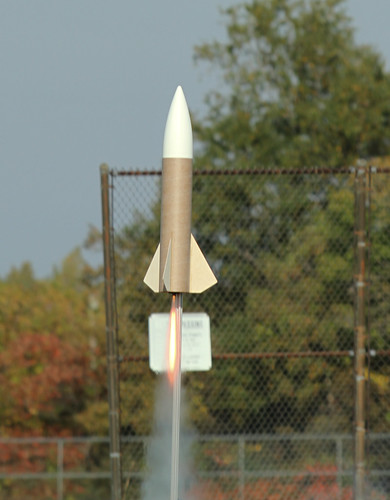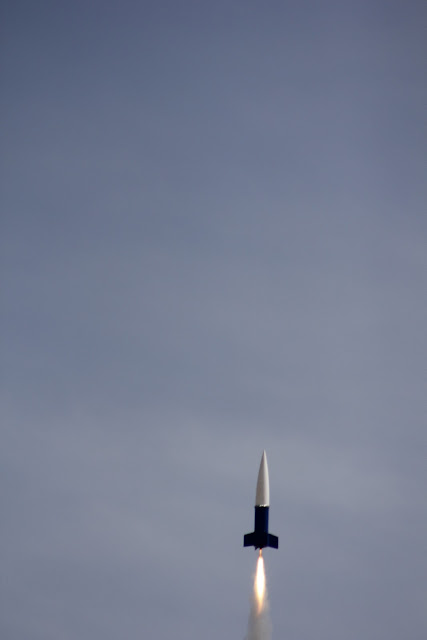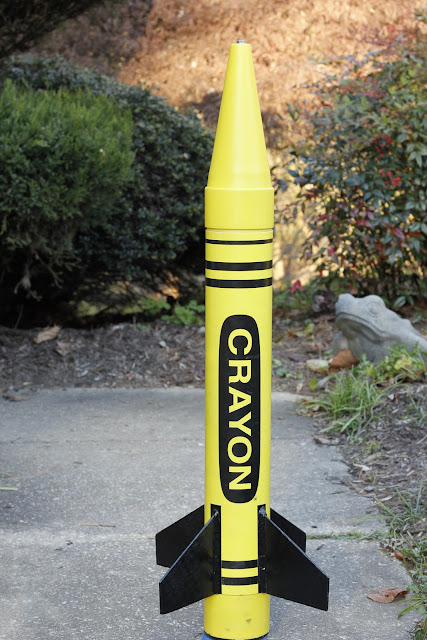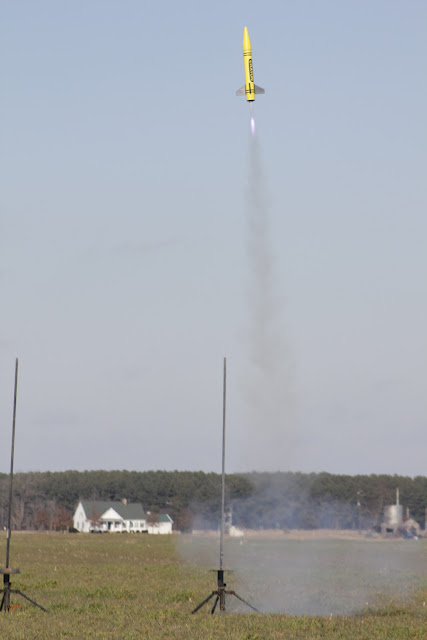You are using an out of date browser. It may not display this or other websites correctly.
You should upgrade or use an alternative browser.
You should upgrade or use an alternative browser.
Largest Mid-Power...
- Thread starter WizardOfAZ
- Start date

Help Support The Rocketry Forum:
This site may earn a commission from merchant affiliate
links, including eBay, Amazon, and others.
I like big rockets! No, I LOVE big rockets! Just curious what are some of the larger rockets that have been flown on mid-power motors. Anyone know any particular rockets or have photos? I'd be curious to know max diameter, length and weight. I'd really like to build and fly a large diameter mid-power...
So as far as affordable lightweight materials go (not carbon fiber), what would be ideal materials?
I built and flew a 1/48 scale Saturn-V. I had to redesign and rebuild it several times before I got it under 3.3 lbs with motor installed. I flew it on a RoadRunner G-80. I don't think the thrust ring would have taken a G-76; 36 pounds of thrust is hefty.
It is a totally paper model. The airframe is single flute cardboard, fluted inside with the centering rings slipping into grooves made by slicing away the flutes to the same thickness as the ring, and the centering rings are regular cardboard with mostly open space. The outside of the airframe is a paper wrap that I drew in Auto-CAD, printed and wrapped over the airframe, securing it with spray adhesive to the cardboard with a single strip of clear scotch tape on the seam. The whole model got a coat of Krylon Clear to protect it from moisture when I'm flying. The center stuffing tube for the ejection gas is a Totally Tubular 4" diameter tube - very thin wall, but I should have used a 2.5 in tube - the parachute almost didn't come out because of pressurizing that much space with just one engine's ejection charge. Everything except the parachute and attaching hardware is paper or cardboard - nice and lite! The parachute is a 36" ripstop nylon red and black chute I purchased from Apogee Components. The F-1 engine bells are permanent, with only the center bell holding the engine. They are overwrapped with silver paper I purchased from Hobby Lobby. The Saturn-V is 8.25" in diameter and stands almost 8 feet tall without the Apollo Boost Cover. The Boost Cover is also paper and is for display only - far too fragile to fly. Even the fins are scale. Once you get really tall the need for stabilizing fins diminishes considerably so I didn't have to enlarge them. I used a 7/16" diameter 7 foot long launch rod that runs up the side of the 4" stuffing tube inside a 6 foot 6 inch 1/2" inside diameter tube, completely buried internally. Only 6' of the rail actually goes into the rocket; the other foot is below the launch surface of the pad and is secured to the pad underneath.
Oh yea, I asked for and got the first launch slot of the day, almost still air. It was too light for wind, and probably would have weather cocked badly. It had lots of drag so it didn't go very high, maybe 450 feet, but it was a nice slow liftoff. I could follow it all the way up with ease. But that's the effect I wanted. It was a Cub Scout launch and I didn't want it to go too fast to see. They were suitably impressed and asked lots and lots of questions - for hours.
I'm contemplating a high power version with all 5 engines running - staging to a live 2nd stage for more heart-pounding excitement. Of course that'll weigh more than 3.3 lbs


Last edited:
gldknght
Well-Known Member
I have a Loc TriStar build in progress and 3 mid range F motors for it's maiden flight. That's mid power right? Works out to 1.5 G motors.
qquake2k
Captain Low-N-Slow
- Joined
- Jan 26, 2010
- Messages
- 13,574
- Reaction score
- 65
I have a Loc TriStar build in progress and 3 mid range F motors for it's maiden flight. That's mid power right? Works out to 1.5 G motors.
I would definitely consider that mid power.
WizardOfAZ
Well-Known Member
- Joined
- Mar 27, 2011
- Messages
- 434
- Reaction score
- 0
Wow! Nice job on the Saturn!
JPVegh
Well-Known Member
- Joined
- Feb 21, 2011
- Messages
- 4,419
- Reaction score
- 9
Wow! Nice job on the Saturn!
Ditto!!! This shows what you can do when your willing to push the limits. I don't know why you couldn't apply some of the same techniques towards something like a Patriot or a High Flyer and come up with a really large light weight mid power.
It would be interesting to do the sims to see what the limits of size are assuming extremely low mass and optimized aerodynamics. Perhaps a very large rocket could be built with helium filled chambers to lighten it up.
WizardOfAZ
Well-Known Member
- Joined
- Mar 27, 2011
- Messages
- 434
- Reaction score
- 0
Ditto!!! This shows what you can do when your willing to push the limits. I don't know why you couldn't apply some of the same techniques towards something like a Patriot or a High Flyer and come up with a really large light weight mid power.
It would be interesting to do the sims to see what the limits of size are assuming extremely low mass and optimized aerodynamics. Perhaps a very large rocket could be built with helium filled chambers to lighten it up.
Interesting idea. But it takes a lot of helium to lift a small amount. Chances are, the helium wouldn't support the weight of the extra body tube around it.
Basically, the limit is 3.3 lbs. So, how about a large diameter lightweight that stays just under? If it was slow enough, a foam nose would probably work ok with some sealant. In fact,,, how about a foam rocket with exterior coating? A motor tube could still be used inside for proper ejection. Essentially, it would be a regular rocket with a large foam exoskeleton! Now there's an idea!
rockets4kids
Well-Known Member
- Joined
- Feb 6, 2011
- Messages
- 433
- Reaction score
- 0
Perhaps a very large rocket could be built with helium filled chambers to lighten it up.
You still have the inertial mass to overcome, along with the drag of a large fat rocket. I doubt this would have any effect at all.
JPVegh
Well-Known Member
- Joined
- Feb 21, 2011
- Messages
- 4,419
- Reaction score
- 9
Interesting idea. But it takes a lot of helium to lift a small amount. Chances are, the helium wouldn't support the weight of the extra body tube around it.
Basically, the limit is 3.3 lbs. So, how about a large diameter lightweight that stays just under? If it was slow enough, a foam nose would probably work ok with some sealant. In fact,,, how about a foam rocket with exterior coating? A motor tube could still be used inside for proper ejection. Essentially, it would be a regular rocket with a large foam exoskeleton! Now there's an idea!
Yeah, the helium idea was more of a conceptual exercise. Though, the compartments could be as simple as plain rubber or mylar balloons and could actually be structual components adding rigidity to the otherwise light and flimsy airframe. Think bigger Estes Dude with some reinforcing strips.
kjohnson
mox nix
- Joined
- Jan 19, 2009
- Messages
- 1,367
- Reaction score
- 68
Here's a biggie- 70" by 8".
https://rocketdungeon.blogspot.com/2010/12/review-grand-whazoo.html#more
kj
https://rocketdungeon.blogspot.com/2010/12/review-grand-whazoo.html#more
kj
I built my Mini Magg lightly and it comes in just under 3.3 pounds loaded with a G77-4in an aeropack adapter. I used epoxy building it, If I did it again I'd likely use wood glue. I'd also consider building with a 29mm, or 2X 29mm mount. Everyone seems to hesitate when you mention launching one on a G. I've done it on a G77-4R, and multiple others have used G76's. I've got a CTI 1 grain G78BS I'm going to launch it on to avoid the adapter weight.
Light wind off a rail:

video: https://www.youtube.com/watch?list=...=gZ_vDX_4TEU&feature=player_detailpage#t=109s
Light wind off a rail:

video: https://www.youtube.com/watch?list=...=gZ_vDX_4TEU&feature=player_detailpage#t=109s
WizardOfAZ
Well-Known Member
- Joined
- Mar 27, 2011
- Messages
- 434
- Reaction score
- 0
I don't have sim software. If I buy another Executioner kit, make it 29mm and extend the body, can anyone tell me what kind of length I could add? Thanks.
Also, I have a 38-29 adapter. If I put that in my LOC Forte, what size 29mm could I fly it on?
Thanks in advance!
Also, I have a 38-29 adapter. If I put that in my LOC Forte, what size 29mm could I fly it on?
Thanks in advance!
qquake2k
Captain Low-N-Slow
- Joined
- Jan 26, 2010
- Messages
- 13,574
- Reaction score
- 65
I don't have sim software. If I buy another Executioner kit, make it 29mm and extend the body, can anyone tell me what kind of length I could add? Thanks.
Also, I have a 38-29 adapter. If I put that in my LOC Forte, what size 29mm could I fly it on?
Thanks in advance!
Open Rocket and Thrustcurve are both free. Open Rocket is Java based design software. I highly recommend it. It will open Rocksim files which are readily available. With Open Rocket, you can add whatever length you want, and it will tell you if it'll be stable.
Thrustcurve is an online flight simulation program. I use it for all my rockets, and it's worked very well for me.
Open Rocket: https://openrocket.sourceforge.net/
Thrustcurve: https://www.thrustcurve.org/
Rocksim files for the Executioner can be found here: https://www.rocketreviews.com/estes-executioner-3776.html
qquake2k
Captain Low-N-Slow
- Joined
- Jan 26, 2010
- Messages
- 13,574
- Reaction score
- 65
Also, I have a 38-29 adapter. If I put that in my LOC Forte, what size 29mm could I fly it on?
If you use Thrustcurve, it'll tell you which motors you can use for a particular rocket, and the estimated altitudes and delay times. Below is what I got using Thrustcurve. I added an ounce to the stock weight to allow for the adapter.
Our LOC IV has flown just fine with Roadrunner F60's. You don't need to go G for a 4" bird!
That paper Saturn, though, is most impressive! Would love to see video of that slow flight! Please post.
-Ken
That paper Saturn, though, is most impressive! Would love to see video of that slow flight! Please post.
-Ken
WizardOfAZ
Well-Known Member
- Joined
- Mar 27, 2011
- Messages
- 434
- Reaction score
- 0
Thanks!
Disaster_Guy
Well-Known Member
- Joined
- Nov 9, 2011
- Messages
- 779
- Reaction score
- 10
I picked this one up built from a forum member for my little girl. Pretty simple 4" 4FNC that has been lightly glassed. Flies great on a G79 or G80:


Another very simple inexpensive build that can fly on a G80 or better:


Another option for "big" on a different scale would be the Fliskits Richter Recker. It is 92" tall and flies on a 24mmx3 cluster.


Another very simple inexpensive build that can fly on a G80 or better:


Another option for "big" on a different scale would be the Fliskits Richter Recker. It is 92" tall and flies on a 24mmx3 cluster.
Polyalcoholic
Well-Known Member
- Joined
- Mar 29, 2012
- Messages
- 159
- Reaction score
- 0
Anyone have an OP or Rocksim file on the Mini Mag.
TA
Try the Rocksim library
https://www.rocketreviews.com/rocksim-9483.html
Similar threads
- Replies
- 24
- Views
- 767
- Replies
- 18
- Views
- 819
- Replies
- 57
- Views
- 5K
- Replies
- 48
- Views
- 2K




